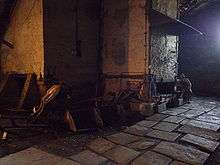Walloon forge
A Walloon forge (or Walloon process) is a type of finery forge that decarbonizes pig iron into wrought iron.

The process was conceived in the Liège region, and from there extended to France,[1] then England around the end of the 15th century.[2][3] Louis de Geer brought it to Roslagen in Sweden at the beginning of the 17th century, with Walloon blacksmiths.[4][5]
The Walloon process spread to Sweden in the Uppland province north of Stockholm, where it was used to produce a specific kind of wrought iron called oregrounds iron.
In Sweden
The source material was pig iron produced by a blast furnace using charcoal and the manganese rich iron ore from the Dannemora mine. A "V" shaped hearth using charcoal was used to heat up the pig iron bar that was presented to a tuyere that decarbonized it and made it melt and fall in drops that solidified in a pool of slag where the decarburization continued[6]. The iron drops were picked up with an iron bar and presented again in front of the tuyere and one by one agglomerated into a ball. That heterogeneous iron was full of slag and the carbon content ranged from pure iron to nearly pig iron. It was therefore reheated in a chafery and hammered and folded using a waterwheel powered trip hammer.
The ore from Dannemora was very low in sulphur and high in manganese. It is possible the manganese bonded with the impurities during the oxidation, creating a pretty pure wrought iron. The use of charcoal prevented the contamination with impurities usually associated with the usage of coal or coke, of which Sweden has none. In England, the chafery might use coal or coke, as in this stage the iron is solidified and the contamination remain low.
The iron was sold to England, where it was recarbonized into blister steel using the cementation process. This steel still contain some slag, and if the carbon was around 1% at the surface, it was lower in the center. The blister steel was than purchased by Benjamin Huntsman who melted it in a crucible heated using coke and poured it. This modern crucible steel was different from the medieval wootz, but was homogeneous and without slag.
References
- Allan H. Kittel, The Revolutionary Period of the Industrial Revolution, p. 130
- B. G. Awty, ‘The continental origins of Wealden ironworkers’ Economic History Review Ser.
- B. G. Awty, ‘The origin of the blast furnace: evidence from the frankophone areas’ Historical Metallurgy 21(2) (1987), 96-99
- M. Nisser, 'Bergslagen' in B. Holtze and others (eds.
- Philippe Bastin (December 2001). "Sur la trace des Wallons de Suède". Retrieved 2 June 2020.
- American iron 1607-1900 by Robert Boyd Gordon